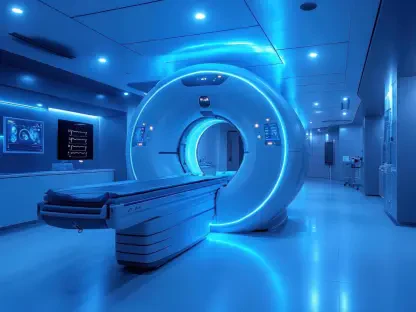In an era where healthcare costs continue to spiral and patient expectations evolve, imagine a system where diseases are predicted before symptoms emerge, treatments are tailored to individual genetic profiles, and care is delivered seamlessly at home through a smartphone. This is not a distant dream but a rapidly approaching reality, driven by artificial intelligence (AI) and cutting-edge technology. The healthcare industry stands on the brink of a monumental transformation, with projections estimating a $1 trillion shift in annual spending by 2035. This report delves into how AI is poised to redefine healthcare, moving from traditional, infrastructure-heavy models to digital-first, consumer-centric frameworks that prioritize prevention and accessibility.
The Current Landscape of Healthcare and the Role of AI
The healthcare sector today remains tied to a legacy model dominated by physical infrastructure, such as sprawling hospital complexes and extensive administrative systems. High operational costs, including overhead for facilities and inefficiencies in paperwork, continue to burden providers and patients alike. This outdated structure struggles to meet the demands of an aging population and the rising prevalence of chronic conditions, creating an urgent need for innovation.
Enter AI and technology, which are emerging as transformative forces in this space. Major players, including tech giants and specialized startups, are driving advancements across critical areas like drug discovery, diagnostics, and patient management. Digital platforms are facilitating seamless data sharing and interoperability, enabling real-time insights that enhance decision-making. These tools are not mere add-ons but are becoming integral to reducing costs and improving outcomes.
The influence of AI is already visible in areas such as automated administrative tasks and early disease detection. Key segments like precision diagnostics and personalized medicine are gaining traction, supported by machine learning algorithms that analyze vast datasets. As these technologies mature, they are laying the groundwork for a fundamental overhaul of how healthcare operates, shifting the focus from reactive treatment to proactive care.
Key Drivers of the $1 Trillion Shift
Emerging Technologies and Trends in Healthcare
AI is at the forefront of revolutionizing healthcare through breakthroughs that once seemed unimaginable. Accelerated drug discovery, powered by AI models, is slashing development timelines, identifying potential compounds in months rather than years. Enhanced diagnostic precision, enabled by image recognition and pattern analysis, allows for earlier detection of conditions like cancer, often before symptoms appear.
Beyond diagnostics, robotic assistance in surgeries is reducing complication rates and improving recovery times by providing unparalleled accuracy. Virtual-first delivery models are also transforming care, with telemedicine platforms and home healthcare programs replacing traditional inpatient visits. Wearable sensors and connected devices monitor vital signs in real time, empowering patients and providers to address issues promptly, often from the comfort of home.
Another pivotal trend is the use of digital twins—virtual replicas of patients that simulate health scenarios for tailored treatment plans. Coupled with the shift of chronic care management from hospitals to home settings, these innovations are redefining patient experiences. Continuous glucose monitors and remote rehabilitation tools exemplify how technology supports personalized prevention, reducing the strain on physical healthcare facilities.
Market Projections and Consumer Influence
According to forecasts by PwC, healthcare spending is expected to undergo a $1 trillion shift by 2035, redirecting funds from bloated administrative overhead and brick-and-mortar costs to AI-enabled systems and in-home care solutions. This financial pivot reflects a broader move toward efficiency, where technology streamlines operations and prioritizes patient-centric models over outdated frameworks.
A significant catalyst for this change is the rise of “super consumers”—high-income, tech-savvy individuals earning substantial annual incomes who are willing to invest out-of-pocket in cutting-edge health solutions. Their demand for innovative tools and services is driving rapid advancements, setting trends that influence broader market dynamics. Over the next decade, this consumer push is anticipated to encourage adoption by governments and commercial entities, amplifying the scale of transformation.
The ripple effect of these investments is profound, as they spur the development of next-generation systems that benefit wider populations. From virtual care platforms to predictive health tools, the influence of these early adopters is reshaping industry priorities. This consumer-driven momentum underscores a critical transition toward a healthcare ecosystem that values accessibility and customization over traditional constraints.
Challenges in Adopting AI in Healthcare
Despite the promise of AI, its integration into healthcare is not without hurdles. A striking disparity exists between adoption and governance, with 88% of health systems utilizing AI internally, yet only 18% possessing mature strategies or oversight structures. This gap highlights a critical lag in establishing frameworks to manage the complexities of AI deployment effectively.
Physicians, while increasingly open to technological tools, express valid concerns about reliability and ethical implications. Questions linger about the accuracy of AI-driven diagnoses and the potential for bias in algorithms, which could undermine trust in these systems. Integration challenges also persist, as many healthcare infrastructures are not equipped to seamlessly incorporate AI without significant upgrades.
Moreover, there is a risk of over-reliance on technology without adequate human oversight. The absence of robust checks and balances could lead to errors or misuse, potentially compromising patient safety. Addressing these issues requires a concerted effort to build confidence among practitioners and ensure that AI serves as a complement to, rather than a replacement for, clinical expertise.
Regulatory and Ethical Considerations for AI in Healthcare
Navigating the regulatory landscape is a cornerstone of responsible AI implementation in healthcare. Robust governance structures are essential to safeguard data security and ensure ethical use, particularly as patient information becomes increasingly digitized. Without clear guidelines, the risk of breaches or misuse looms large, threatening both privacy and public trust.
Compliance requirements also pose a significant challenge, often slowing the pace of technology adoption. Striking a balance between innovation and adherence to standards is crucial to prevent stifling progress while maintaining accountability. Regulatory bodies must evolve alongside technological advancements to address emerging risks without creating unnecessary barriers.
Equally important is the ethical dimension, which demands that AI systems prioritize equity in care delivery. Disparities in access to technology could exacerbate existing inequalities if not addressed proactively. Ensuring that innovation benefits all segments of society, rather than a privileged few, remains a pressing concern for policymakers and industry leaders alike.
The Future of Healthcare: A Technology-Centric Vision
Looking ahead to 2035, healthcare is projected to evolve into a proactive, automated, and virtually accessible system. Hospitals are expected to transform into specialized hubs focused on acute and complex care, while routine and chronic management shifts to home-based and remote models. This reimagining prioritizes efficiency and patient convenience over traditional care settings.
Emerging disruptors, such as AI-driven predictive algorithms, are set to play a central role in anticipating health risks and preventing crises before they occur. Consumer-centric models will further empower individuals to take charge of their wellness through intuitive tools and platforms. These advancements signal a departure from one-size-fits-all approaches toward highly individualized care.
Global economic conditions and continuous innovation will also shape this trajectory. As investment in health tech grows, so too will the pressure to adapt to changing market demands and technological capabilities. Organizations that embrace a forward-thinking mindset, leveraging data and automation, are likely to thrive in this dynamic landscape, while laggards risk falling behind.
Conclusion: Navigating the Path to a Digital-First Healthcare System
Reflecting on the insights gathered, it becomes evident that AI and technology have initiated a profound transformation in healthcare, marked by a projected $1 trillion spending shift. The journey reveals a clear trajectory toward improved outcomes through prevention, personalization, and accessibility, fundamentally altering how care is perceived and delivered.
For stakeholders, the path forward demands a strategic focus on harmonizing innovation with governance. Establishing comprehensive oversight mechanisms proves essential to address ethical concerns and ensure equitable access, preventing the digital divide from widening. Prioritizing interoperable systems also emerges as a key step to enhance data-driven decision-making across diverse platforms.
Looking beyond immediate challenges, the emphasis shifts to fostering collaboration among providers, regulators, and tech developers. By investing in scalable solutions and actionable intelligence, the industry can sustain momentum and avoid obsolescence. This collective effort promises to build a resilient, digital-first healthcare ecosystem that delivers high-quality care to all.









